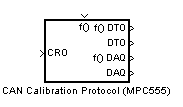

| Embedded Target for Motorola MPC555 |   |
Implement the CAN Calibration Protocol (CCP) standard
Library
Embedded Target for Motorola MPC555
Description
The CAN Calibration Protocol block provides an implementation of a subset of the CAN Calibration Protocol (CCP Version 2.1). CCP is a protocol for communicating between the target processor and the host machine over CAN. In particular, a calibration tool (see Compatibility with Calibration Packages) running on the host can communicate with the target, allowing remote signal monitoring and parameter tuning.
This block processes a Command Receive Object (CRO) and outputs the resulting Data Transmission Object (DTO) and Data Acquisition Messages (DAQ).
For more information on CCP refer to ASAM Standards: ASAM MCD: MCD 1a on the Association for Standardization of Automation and Measuring Systems (ASAM) Web site:
The CAN Calibration Protocol block inputs are
These inputs and outputs can be used to set up generic data I/O for the block.
Using the DAQ Output
The DAQ output is the output for any CCP Data Acquisition Lists that have been set up. You can use the ASAP2 file generation feature of the RT target to
Once these signals are set up, Event Channels then periodically fire events that trigger the transmission of DAQ data to the host. When this occurs, CAN messages with the appropriate CCP / DAQ data appear on the DAQ output, along with an associated function call trigger.
It is the responsibility of the calibration tool (see Compatibility with Calibration Packages) to use CCP commands to assign an Event Channel and data to the available DAQ lists, and to interpret the synchronous response.
Using DAQ lists for signal monitoring has the following advantages over the polling method:
Data is guaranteed to be consistent. The transmission takes place after the signals have been updated, so there is no risk of interruptions while sampling the signal.
Dialog Box
uint16. It is used to distinguish between different targets. By assigning unique station addresses to targets sharing the same CAN bus, it is possible for a single host to communicate with multiple targets.Standard(11-bit identifier) or Extended(29-bit identifier).Supported CCP Commands
The following CCP commands are supported by the CAN Calibration Protocol block:
CONNECT
DISCONNECT
DNLOAD
DNLOAD_6
EXCHANGE_ID
GET_CCP_VERSION
GET_DAQ_SIZE
GET_S_STATUS
SET_DAQ_PTR
SET_MTA
SET_S_STATUS
SHORT_UP
START_STOP
START_STOP_ALL
TEST
UPLOAD
WRITE_DAQ
Compatibility with Calibration Packages
This CCP implementation has been tested successfully with the Vector-Informatik CANape calibration package running in both DAQ List and Polling mode, and with the Accurate Technologies Inc. Vision calibration package running in DAQ List mode. (Note that Accurate Technologies Inc. Vision does not support the Polling mechanism for signal monitoring).
Extended Functionality
The CAN Calibration Protocol block also supports the PROGRAM_PREPARE command. This command is an extension of CCP that allows the automatic download of new code into the target memory. On receipt of the PROGRAM_PREPARE command, the target will reboot and begin the CAN download process. This lets you download new application code to RAM or flash memory, or download new boot code to flash memory.
 | Alphabetical List of Blocks | CAN Message Filter |  |